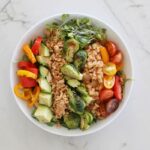Unlock the secrets to crafting exquisite paleo dinners that rival your favorite restaurant’s offerings, all from the comfort of your own kitchen. This comprehensive guide unveils the techniques and recipes needed to transform simple ingredients into culinary masterpieces. Imagine succulent, perfectly seasoned proteins paired with vibrant, flavorful vegetables, all while adhering to the principles of the paleo diet. Prepare to embark on a delicious journey of culinary exploration, mastering advanced cooking methods and discovering the art of creating balanced, satisfying meals that are both healthy and incredibly appetizing.
From mastering essential paleo ingredients and advanced cooking techniques to crafting mouthwatering sauces and perfectly plated dinners, this guide provides a step-by-step roadmap to success. Learn how to select the finest quality ingredients, unlock their full potential through precise cooking methods, and elevate your culinary skills to a whole new level. Discover the joy of creating restaurant-quality meals at home, impressing yourself and your loved ones with each delectable bite.
Mastering Paleo Cooking Techniques for Elevated Dishes

Elevating your paleo dinners from simple to spectacular requires mastering a few key techniques. These methods not only enhance the flavor and texture of your dishes but also unlock a deeper appreciation for the inherent qualities of paleo ingredients. By understanding and applying these techniques, you can create restaurant-quality meals in the comfort of your own kitchen.
Advanced Paleo Cooking Techniques
Several advanced cooking techniques significantly improve the taste and texture of paleo dishes. These techniques, often employed in professional kitchens, can be easily adapted for home use, resulting in meals that are both delicious and nutritious. Proper application ensures even cooking, maximizing flavor development, and creating textures that are both appealing and satisfying.
- Sous Vide: This method involves cooking food in a temperature-controlled water bath, resulting in incredibly tender and juicy results. The precise temperature control ensures even cooking throughout, eliminating overcooking and preserving moisture. Perfect for tougher cuts of meat like chuck roast or chicken thighs.
- Reverse Searing: This technique involves cooking the meat low and slow in the oven before searing it at high heat. This ensures a perfectly cooked interior with a beautiful, crispy crust. Ideal for achieving a tender and flavorful steak.
- Broiling: Broiling utilizes intense top heat to quickly sear and brown the surface of food, creating a delicious crust while keeping the inside moist. Excellent for vegetables like asparagus and bell peppers.
- Smoking: Infusing food with smoky flavors using wood chips or chunks adds depth and complexity. This technique works well with meats and fish, imparting a rich, nuanced flavor profile.
- Blanching: Briefly cooking vegetables in boiling water then immediately plunging them into ice water stops the cooking process and preserves their vibrant color and crisp texture. Ideal for preparing vegetables for salads or as a side dish.
Step-by-Step Guide: Reverse Searing a Ribeye Steak
Reverse searing delivers a perfectly cooked steak every time. The process involves slow cooking in the oven to ensure even doneness, followed by a quick sear to develop a flavorful crust.
- Season the Steak: Generously season both sides of a 1.5-inch thick ribeye steak with salt, pepper, and garlic powder.
- Low and Slow: Preheat your oven to 275°F (135°C). Place the seasoned steak on a wire rack set over a baking sheet. Roast for approximately 1-1.5 hours, or until the internal temperature reaches 125-130°F (52-54°C) for medium-rare.
- Sear to Perfection: Remove the steak from the oven and let it rest for 10 minutes. Heat a heavy skillet over high heat until it’s smoking hot. Add a tablespoon of high-heat oil (like avocado or grapeseed oil). Sear the steak for 1-2 minutes per side, until a deep brown crust forms.
- Rest and Serve: Remove the steak from the skillet and let it rest for another 5-10 minutes before slicing and serving. This allows the juices to redistribute, resulting in a more tender and flavorful steak.
Applying Different Heat Sources to Paleo Dishes: Roasted Chicken with Root Vegetables
This recipe demonstrates the versatility of different heat sources in preparing a complete paleo meal.
- Oven Method: Preheat oven to 400°F (200°C). Toss chopped carrots, parsnips, and sweet potatoes with olive oil, salt, pepper, and rosemary. Spread on a baking sheet. Place a whole chicken (about 3-4 lbs) seasoned with salt, pepper, and thyme in a roasting pan. Roast for 1 hour and 15 minutes, or until the chicken is cooked through and the vegetables are tender. The oven method results in evenly cooked chicken and vegetables with a slightly softer texture.
- Grill Method: Preheat grill to medium-high heat. Prepare the chicken and vegetables as above. Grill the chicken, turning occasionally, for about 45-60 minutes, or until cooked through. Grill the vegetables in foil packets for about 20-25 minutes, or until tender. The grill imparts a smoky char to both the chicken and vegetables, resulting in a bolder flavor profile.
- Skillet Method: Heat a large skillet over medium-high heat. Add a tablespoon of olive oil. Sear the chicken pieces until golden brown on all sides. Add the chopped vegetables and cook until tender-crisp, stirring occasionally. The skillet method results in a quicker cooking time and develops a nice sear on the chicken.
The oven method yields tender, juicy chicken and soft vegetables. The grill method adds a smoky flavor and a slightly charred exterior to both. The skillet method provides a quicker cooking time and develops a nice sear on the chicken.
Seasoning and Flavor Combinations in Paleo Cooking
Proper seasoning is crucial for creating truly exceptional paleo dishes. Strategic use of herbs, spices, and flavorful fats elevates even the simplest ingredients.
Examples of effective spice blends and herb combinations include:
- For Chicken: Rosemary, thyme, garlic powder, paprika, and a pinch of cayenne pepper.
- For Beef: Smoked paprika, onion powder, garlic powder, black pepper, and a touch of sea salt.
- For Fish: Dill, lemon zest, garlic powder, and a pinch of red pepper flakes.
- For Vegetables: A blend of Italian herbs (oregano, basil, thyme), garlic powder, and a drizzle of olive oil.
Remember to adjust seasoning according to your taste preferences. Experimenting with different combinations is key to discovering your favorite flavor profiles.
Mastering the art of restaurant-worthy paleo dinners at home is a rewarding journey of culinary exploration. By understanding the essential ingredients, mastering advanced cooking techniques, and embracing the principles of balanced plating, you can transform your kitchen into a haven of delicious, healthy meals. This guide has equipped you with the knowledge and skills to create unforgettable dining experiences, celebrating the vibrant flavors of paleo cuisine while showcasing your culinary prowess. So, gather your ingredients, embrace your creativity, and savor the delicious results of your newfound culinary expertise.
FAQ Overview
Can I adapt these recipes for different dietary needs (e.g., allergies)?
Absolutely! Many substitutions are possible. The guide often suggests alternatives, and you can adjust ingredients based on your specific needs and preferences. Always check ingredient labels carefully.
How long does it take to prepare these dishes?
Preparation times vary depending on the recipe’s complexity. Some dishes are quick weeknight meals, while others are ideal for a leisurely weekend cooking project. Each recipe includes estimated preparation and cooking times.
What kind of equipment do I need?
While some recipes can be made with basic kitchen tools, others might require specialized equipment (e.g., sous vide). Each recipe specifies the necessary tools and equipment.
Where can I find the paleo ingredients?
Most paleo-friendly ingredients can be found at your local grocery store, farmers’ markets, or specialty food stores. The guide provides suggestions for sourcing ingredients.
Are these recipes suitable for beginners?
While some techniques are advanced, the guide is designed to be accessible to cooks of all skill levels. Step-by-step instructions and helpful tips are provided throughout.


